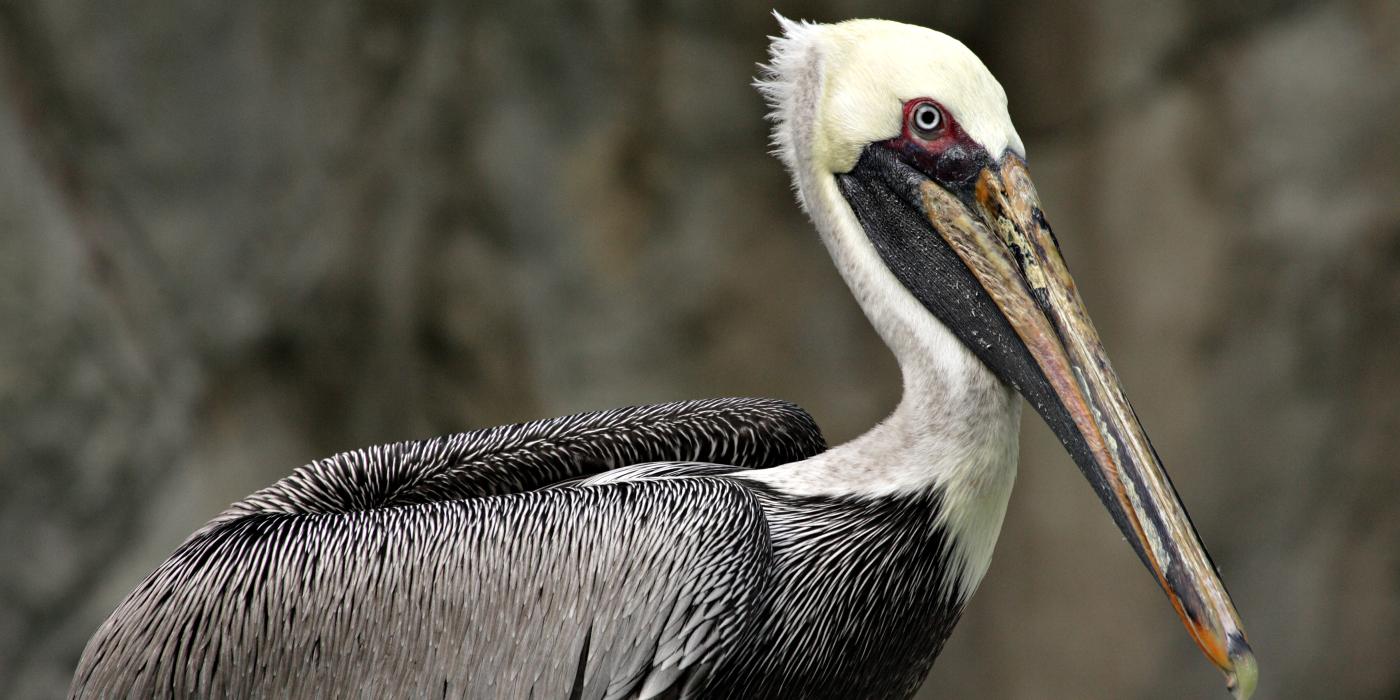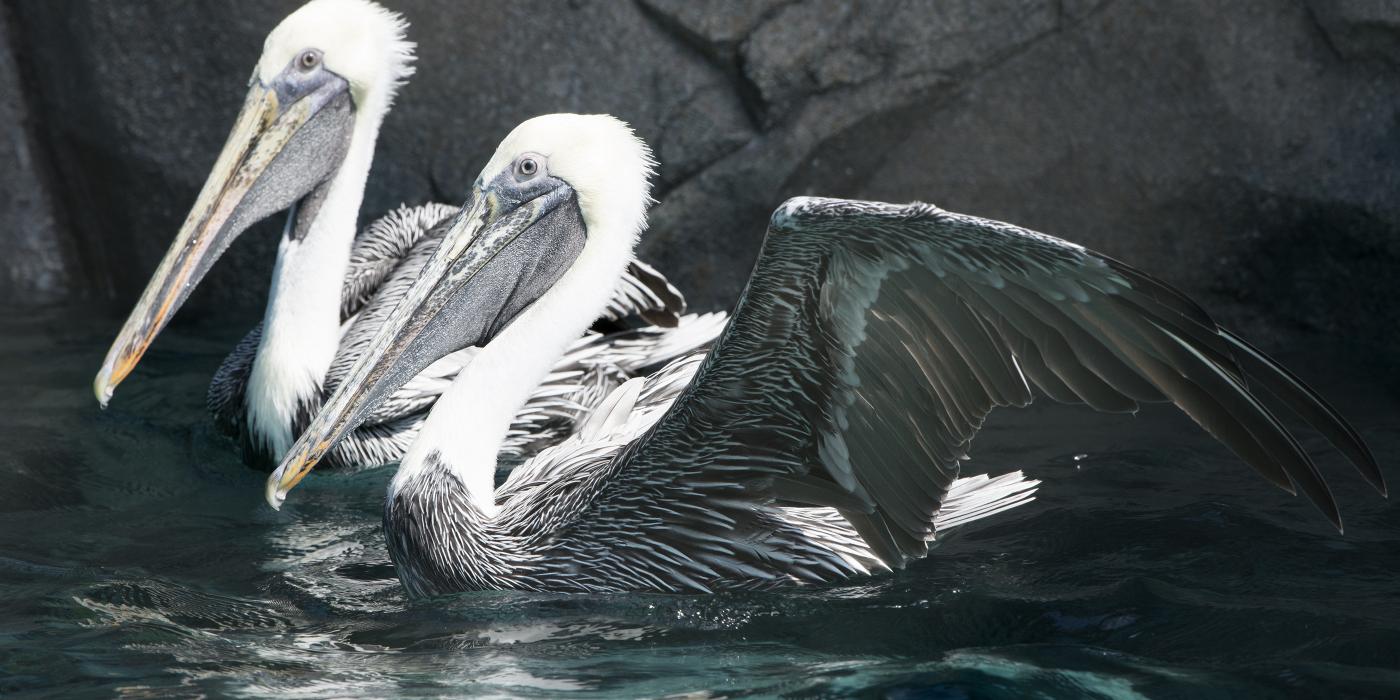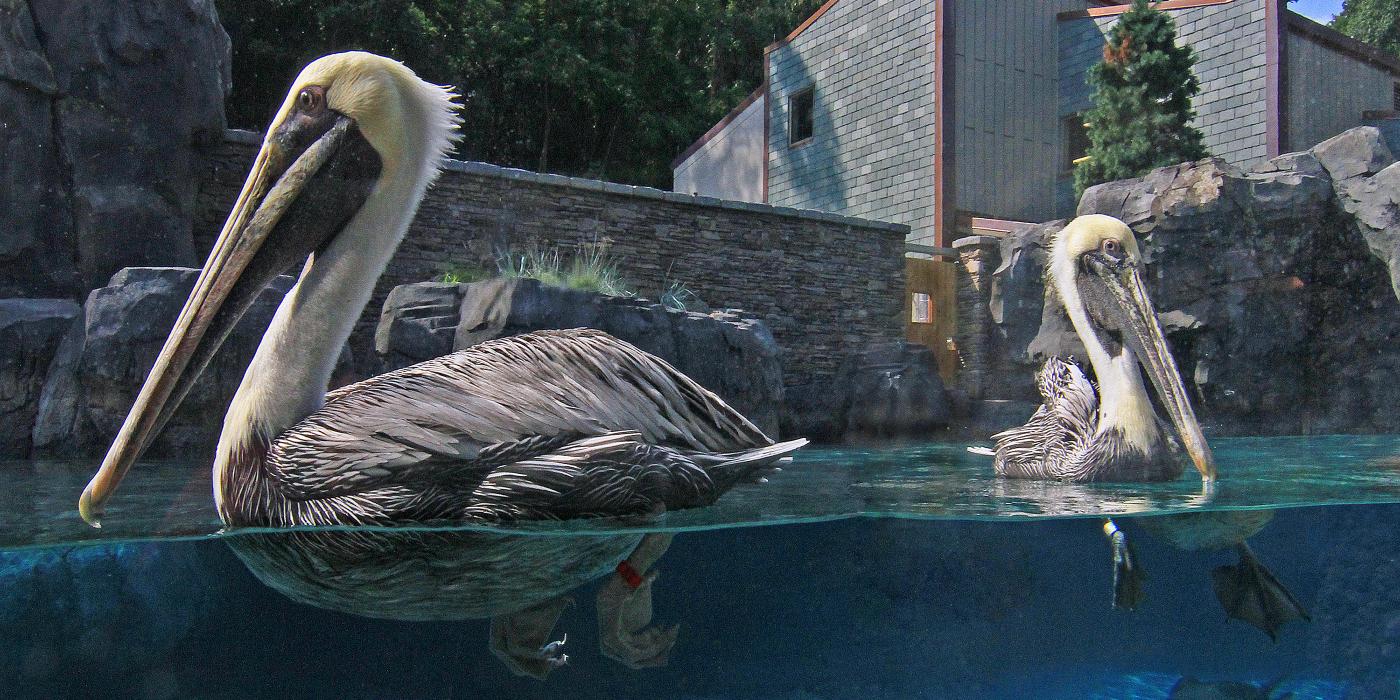Physical Description
Males and females are similar in plumage; the head is white with a pale yellow wash on the crown; the long bill is grayish; back, rump, and tail are streaked with gray and dark brown; the breast and belly are a blackish-brown; eyes pale yellow; and legs and feet are black.
Immature pelicans have brownish-grey necks and white underparts. They will gradually acquire their adult plumage over a period of about three years. The brown pelican's most distinguishing feature is a long beak measuring approximately 9 inches (23 centimeters) in length with a hooked tip and large pouch beneath. The huge naked skin pouch suspended from the lower half of the hooked bill holds two or three times more than the bird's stomach—about one gallon of water and fish. Pelicans hold their catch and let the water drain from the corners of their mouths before they swallow. Fish are never carried in the pouch, but in the gullet or esophagus. The pouch is also pulsated in extreme heat to allow cooling.
In flight, brown pelicans are easily identified by a pattern of a few flaps followed by gliding.
Size
Brown pelicans are the smallest species of pelican. Both males and females are 3 to 5 feet (0.9 to 1.5 meters) long and weigh over 7 pounds (3 kilograms).
Native Habitat
Of the seven or eight species of pelican, the brown pelican (also called the American brown pelican or common pelican) can be found from Virginia, south to the mouth of the Amazon River in Brazil, from central California to south-central Chile and the Galapagos Islands, and in Alabama, Louisiana and Texas along the Gulf Coast.
Lifespan
Brown pelicans typically live 25 to 30 years.
Communication
Adult brown pelicans make very few vocalizations. Occasionally, they will make a low croak. Nestlings squeal.
Food/Eating Habits
Brown pelicans use their pouch, swimming ability, and extremely keen eyesight to catch fish. Flying over the ocean, they can spot a school of small fish from heights of 60 to 100 feet (30 m). After spotting the fish, the pelican folds back its wings and dives deep into the water, submerging completely or partially before emerging with a mouthful of fish. Air sacs beneath the pelican's skin cushion the impact and help it resurface.
Brown pelicans are the only species of pelican that hunts with such dramatic plunging dives. Other pelican species fish by swimming on the surface of the water, which is also a method sometimes used by juvenile brown pelicans. Their pouch, which they use as a dip net, holds the catch of fish until the water (as much as 3 gallons) is squeezed out. The pouch itself can hold three times more fish than the stomach. While fish is being held in the pouch, gulls often hover above or even sit on the pelican's bill ready to steal a fish or two. Once the water has drained from the pouch, the pelican swallows the fish. The pouch also serves as a cooling mechanism and as a feeding trough for young pelicans.
Brown pelicans feed on mid-sized fish and some invertebrates. They require up to 4 pounds of food per day. Their diet consists mainly of menhaden, herring, sheepshead, pigfish, mullet, grass minnows, top minnows and silversides—all fish considered commercially unimportant.The brown pelicans' diet at the Smithsonian's National Zoo consists of thread herring. They are also given vitamin supplements based on the amount of fish they eat.
Social Structure
Pelicans are social and gregarious. Males and females, juveniles and adults, congregate in large flocks for much of the year. In level flight, pelicans fly in groups, with their heads held back on their shoulders, the bills resting on their folded necks. They may fly in a "V," but usually in regular lines or single file.
Reproduction and Development
During breeding season in March or April, males pick a nesting sites and perform an "advertising" display that attracts females. On the Southeast coast, it is often in mangroves that pelicans build their flimsy nests of sticks, reeds, bones and seaweed. On islands without predators, they often build nests on the ground, which may be a shallow depression lined with a few feathers and a rim of soil up to 10 inches, or a large mound of soil and debris with a cavity on top. They nest in colonies, and are sensitive to disturbance by tourists and fisherman while breeding.
Brown pelicans lay two to three chalky, white eggs and incubation lasts about 28 to 30 days. Both parents take turns incubating and feeding the young by regurgitation. Fledging requires 63 to 76 days, possibly longer in tree nests. They perform little-to-no post-fledging care, depending on the length of time the young spent in the nest. Sexual maturity is reached after two to five years.
Conservation Efforts
The brown pelican has few natural enemies. Flooding or hurricanes sometimes destroy ground nests, but the biggest threat comes from humans. In the late 19th and 20th centuries, pelicans were hunted for their feathers to adorn women's clothing and hats. During the food shortages of World War I, fisherman claimed that pelicans were depleting resources from the commercial fishing industry and slaughtered them by the thousands. Their nests were also frequently raided for eggs.
In the 1940s, the pesticide DDT began to be widely used and cause a decline in the pelican population due to eggshell thinning. In 1903, President Roosevelt designated Florida's Pelican Island as the first national wildlife refuge, which helped to reduce the killing of pelicans for their feathers. In addition, passage of the Migratory Bird Treaty Act in 1918 gave protection to pelicans and other birds. Studies proved that pelicans were not harming the commercial fishing industry, which helped to stop the killing of pelicans by fishermen.
In 1970, the U.S. Fish and Wildlife Service listed the brown pelican as an endangered species meaning that it was considered in danger of extinction through all or a significant part of its range.
In 1972, the Environmental Protection Agency banned the use of DDT in the U.S. and placed heavy restrictions on the use of other pesticides. Since the banning of DDT, there has been an increase in nesting success. The brown pelican was the first bird species to recover from the effects of pesticides.
In November 2009, the brown pelican was de-listed and removed from the Endangered Species list.
Today, abandoned fishing lines, other marine debris, and overhead wires still pose a threat to the brown pelican. In Florida, at least 500 pelicans are killed each year from entanglement in fishing gear. The brown pelicans on American Trail are rehabilitated birds, injured in this fashion.
Help this Species
Reduce, reuse and recycle — in that order! Cut back on single-use goods, and find creative ways to reuse products at the end of their life cycle. Choose recycling over trash when possible.
Organize or attend a stream, river, lake or other waterway cleanup in your area to preserve aquatic habitats for local species.
Support organizations like the Smithsonian’s National Zoo and Conservation Biology Institute that research better ways to protect and care for this animal and other endangered species. Consider donating your time, money or goods.
Meet the Animals
Three brown pelicans live at the Smithsonian’s National Zoo and Conservation Biology Institute: Eugene, Pippin, and Frankie.
Eugene is the Zoo’s male brown pelican. He hatched in May 2022 and is a wild rescue, like the other brown pelicans at the Zoo. He came from the Florida Wildlife Hospital in Palm Shores, Fla. He was brought into the rescue facility because of a genetic condition making him unable to grow normal feathers on his right wing. This makes him unable to fly and non-releasable.
Eugene can often be found swimming around the sea lion exhibit. Eugene likes playing with sticks and the decorative kelp in the exhibit.
Want to tell them apart? Eugene has a white head, which is the adult coloration for brown pelicans. He is larger than the other adult pelican, Pippin.
Pippin is one of two female brown pelicans at the Zoo. She hatched in May 2022. Like the Zoo’s other pelicans, she was rescued from the wild. She was brought into the Florida Wild Mammal Association in Crawfordsville, Fla., due to severe frostbite on her feet and wing tips, which had to be amputated. She is not able to fly and therefore non-releasable.
Pippin can often be found sitting on the large branches that span the rocks in the sea lion exhibit, or swimming with Eugene.
Want to tell them apart? Pippin has a white head, which is the adult coloration for brown pelicans. She is smaller than the other adult pelican, Eugene. She is missing the ends of her toes on both feet as well as the tips of her wings due to frostbite.
Frankie is the Zoo’s female brown pelicans. She hatched in May 2023. Frankie is a wild rescue and from the Carolina Wildlife Rehabilitation Center in Warhaw, N.C. She was rescued due to injuries to her wings, making her unable to fly and non-releasable.
Frankie can often be found floating around the sea lion exhibit on her enrichment items, or sitting on the rocks in the center of the exhibit.
Want to tell them apart? Frankie is easy to spot – she is currently the only pelican with a fully brown head, which is the coloration of juvenile brown pelicans.
Animal News

#DCPandas: Happy 4th Birthday, Qing Bao! ›

Canada Lynx Have Arrived at the Smithsonian’s National Zoo ›



